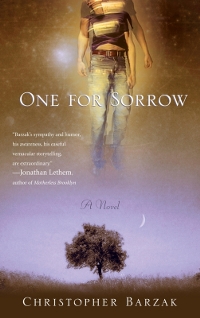
The Haunting Weirdness of Christopher Barzak’s One for Sorrow
Written by: Beth Woodward, CC2K Books Editor
 I am still grappling with a book I read this past week, Christopher Barzak’s debut novel One for Sorrow. It’s told from the perspective of a fifteen-year-old boy named Adam McCormick, who is still reeling from the recent death of his beloved grandmother and a car accident that left his mother paralyzed. When one of his classmates is murdered, Adam begins to see the ghost of the dead boy.
I am still grappling with a book I read this past week, Christopher Barzak’s debut novel One for Sorrow. It’s told from the perspective of a fifteen-year-old boy named Adam McCormick, who is still reeling from the recent death of his beloved grandmother and a car accident that left his mother paralyzed. When one of his classmates is murdered, Adam begins to see the ghost of the dead boy.
That Adam befriends the ghost is not unexpected—at least not for anyone who’s ever read a ghost story before. The way that Adam and the dead boy, Jamie, interact, is. When Adam first meets Jamie, the ghost is naked; this is never explained, and the question of whether Jamie was sexually assaulted before he was murdered is left open. Jamie asks Adam to take off his clothes and lie down in the hole where his body had been found. Adam does so, and ghost Jamie (the ghosts in Barzak’s world are solid entities) climbs in next to him. When I was reading this, what struck me is that I have never met a fifteen-year-old guy who wouldn’t be freaked out by either the fact that a) Jamie is male, or b) Jamie is dead.
That Adam does not ponder the larger implications of his friendship with Jamie is striking, and I don’t know whether I would have believed it from any other character (or from a less competent author). But somehow, Adam’s voice feels so authentic and true that the fact that he doesn’t ask these questions seems fitting somehow. After all, Adam spends the book preoccupied with life-and-death issuess.
Not that either Adam or Jamie had much of a life to begin with. Adam feels alienated from his family: an inattentive father, a quick-tempered mother, and a stoner brother. The only person who understood him was his grandmother, and after her death he becomes something of a loner. Jamie was an unpopular kid, often going unnoticed at school, and his family life borders on abusive. They both lack meaningful human connections, so their growing attachment to one another seems natural. But they also keep each other from their respective destinies. Jamie clings to Adam because it makes him feel more connected to life. And the more time Adam spends with Jamie, the closer to death he becomes.
Barzak’s story, told through Adam’s simple, straightforward voice, is—dare I say it?—haunting. In the end, you still don’t understand exactly why or how everything has happened, the nuances of life and death as portrayed in the story, but this doesn’t really seem to matter. Barzak’s Ohio—where the story takes place—is a magical world, filled with ghosts and monsters and dead spaces. (And trust me, I’ve been there, and there’s nothing magical about Ohio in real life.) As Adam becomes more involved in the mysterious realm of Jamie’s afterlife, so do we. And so we can believe that it’s possible for a person to pop in and out of their body, for a someone to straddle the line between the here and the hereafter, for the dead to feed off of the words of the living.
Jamie and Adam connect to one another in a way that goes beyond friendship—or even sexuality. But, as we are keenly aware throughout the story, it’s also a friendship that never should have been. As the two friends grow closer, they reminisce about lost opportunities, about the times they could have connected when Jamie was alive. But the moment has passed, and the longer they cling to one another, the longer neither can move on.
I think I will need to read this book again to sort out all the intricacies. But, overall, I think the experience will be worth it—possibly even more so the second time around. That Adam is a “typical” teenage boy is obvious. But in the end, Adam’s weirdness makes him a character I could root for that much more.
On another topic: If you ever get to Portland, Oregon, I wholeheartedly recommend checking out Powell’s City of Books. It is reportedly the largest independent bookstore in the world. I was lucky enough to visit Powell’s last week on a trip to Portland, and I was entranced. Take the largest Barnes & Noble you’ve ever seen, multiply it by three, and you still haven’t touched upon the sheer enormity of this place. Powell’s offers an eclectic mix of new, used, and rare books—a much better variety than an average bookstore. I loved that Powell’s offered a greater variety of paperbacks than most stores—convenient, when you know you’re going to be traveling. It’s not as atmospheric as fancier bookstores; the cement floors and oversized shelves give it something of a warehouse feeling. Yet the sheer enormity and diversity of the store is awe-inspiring, so give yourself a lot of time to explore.
Mark my words: If you visit Powell’s City of Books, you will fall in love with it. Being the avid reader/book geek that I am, I was ready to move in. To me, it was just about heaven.
Selected Book Releases, February 16-22
February 17
The Second Opinion by Michael Palmer—Palmer’s fourteenth novel followers a doctor with Asperger Syndrome as she tries to unravel the mystery behind a hit-and-run accident that seriously injured her father.
While My Sister Sleeps by Barbara Delinsky—Explores the dynamics of a family after the oldest daughter, an Olympic contender, falls into a coma after a sudden heart attack.
